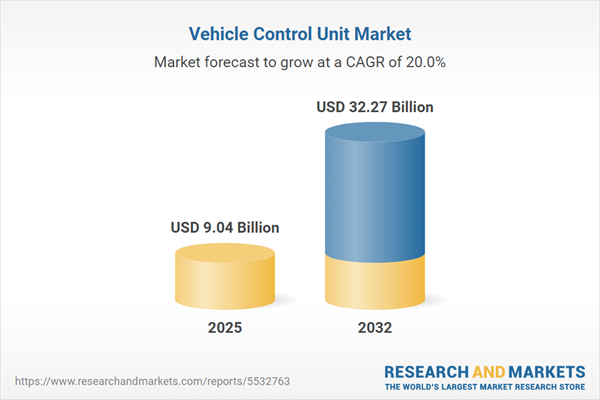Speak directly to the analyst to clarify any post sales queries you may have.
The vehicle control unit market is in a phase of transition as technology innovations and compliance pressures prompt businesses to rethink their operating models. Executives are now prioritizing flexible control architectures that support operational continuity while enabling faster adaptation to market changes.
Vehicle Control Unit Market Snapshot
The global vehicle control unit market is exhibiting steady growth, driven by a positive compound annual growth rate and a rising overall market value. This progress reflects a broad move from hardware-centric models to agile, software-based vehicle control architectures. Automakers are using integrated control units to update their mobility platforms, advancing digitalization and streamlining operations. These changes are integrating foundational management functionalities, fostering efficient orchestration of connected vehicle strategies. As modular digital platforms become more prevalent, organizations are gaining the flexibility needed to respond to legislative change and emerging technology, ensuring real-time decision-making and robust continuity.
Scope & Segmentation in the Vehicle Control Unit Market
This executive market report provides in-depth analysis for decision-makers across procurement, investment, and technology domains. Strategic insights span the main segments and operational layers shaping today’s landscape:
- Sales Channel: Encompasses both aftermarket and original equipment manufacturer frameworks, highlighting how agile supply chains and durable partnerships decrease operational vulnerability.
- Vehicle Type: Covers commercial, passenger, and off-highway vehicles, clarifying the roles and investment strategies unique to each application area.
- Powertrain Technologies: Addresses battery electric, plug-in hybrid, hybrid, internal combustion, and fuel-cell powertrains, focusing on integration, compliance, and performance challenges in vehicle control.
- Transmission Systems: Reviews automatic, dual-clutch, manual, and continuously variable systems, pointing to how modular setups support evolving standards and customer expectations.
- Control Applications: Outlines chassis controls, engine management, and body electronics, indicating where operational efficiency and reliability can unleash further value.
- Regional Coverage: Analyzes key regions, including the Americas, EMEA, and Asia-Pacific, and examines how regulatory frameworks and procurement practices impact growth opportunities and market access.
- Key Companies: Profiles major players such as Bosch, Continental, Denso, ZF Friedrichshafen, Aptiv, Valeo, Vitesco Technologies, Hitachi Automotive, Mitsubishi Electric, and Hyundai Mobis to show technology differentiation and competitive positioning.
Key Takeaways for Senior Decision-Makers
- Deploying software-based, domain-driven strategies allows faster feature rollouts and better alignment with evolving regulatory and consumer expectations.
- Embracing predictive analytics in control systems strengthens maintenance planning and optimizes fleet operations as business priorities shift.
- Building compliance-oriented operating models reduces risk exposure and strengthens resilience during regulatory updates or supply chain adjustments.
- Regional sourcing and production strategies offer organizations an advantage in meeting localized challenges and responding efficiently to market demands.
- Collaboration across OEMs, suppliers, and technology vendors accelerates the introduction of connected mobility solutions and supports continuous improvement.
Tariff Impact: Manufacturing and Supply Chain Dynamics
The scheduled introduction of United States tariffs in 2025 is leading automotive manufacturers to reconsider sourcing and inventory management. Strategies now include greater emphasis on nearshoring, broader supplier bases, and smarter inventory techniques. These adjustments are critical to dampening effects from evolving market policies and safeguard a consistent flow of vehicle control units to diverse regions.
Methodology & Data Sources
This report’s executive recommendations draw from primary interviews with automotive engineers, procurement leads, and compliance professionals. Findings are cross-referenced with industry white papers, patent submissions, external databases, and regulatory analyses to produce focused, well-supported insights.
Why This Report Matters for the Vehicle Control Unit Market
- Helps senior leaders adapt to new integrated control architectures and meet changing compliance requirements, supporting scalability and robust growth strategies.
- Clarifies the supplier ecosystem, supporting rapid contingency planning to address potential disruptions in global and regional market environments.
- Arms decision-makers with practical tools to balance investment risk and opportunity in response to evolving control technology and shifting regulations, strengthening market positioning for the long term.
Conclusion
By understanding current regulatory and technological developments, senior executives can increase organizational resilience, sharpen adaptability, and confidently lead through ongoing transformation in the automotive control unit sector.
Additional Product Information:
- Purchase of this report includes 1 year online access with quarterly updates.
- This report can be updated on request. Please contact our Customer Experience team using the Ask a Question widget on our website.
Table of Contents
3. Executive Summary
4. Market Overview
7. Cumulative Impact of Artificial Intelligence 2025
Companies Mentioned
The companies profiled in this Vehicle Control Unit market report include:- Robert Bosch GmbH
- Continental AG
- Denso Corporation
- ZF Friedrichshafen AG
- Aptiv PLC
- Valeo SA
- Vitesco Technologies Group AG
- Hitachi Automotive Systems, Ltd.
- Mitsubishi Electric Corporation
- Hyundai Mobis Co., Ltd.
Table Information
| Report Attribute | Details |
|---|---|
| No. of Pages | 193 |
| Published | October 2025 |
| Forecast Period | 2025 - 2032 |
| Estimated Market Value ( USD | $ 9.04 Billion |
| Forecasted Market Value ( USD | $ 32.27 Billion |
| Compound Annual Growth Rate | 19.9% |
| Regions Covered | Global |
| No. of Companies Mentioned | 11 |









